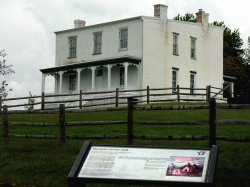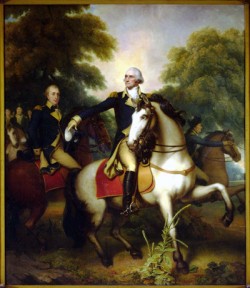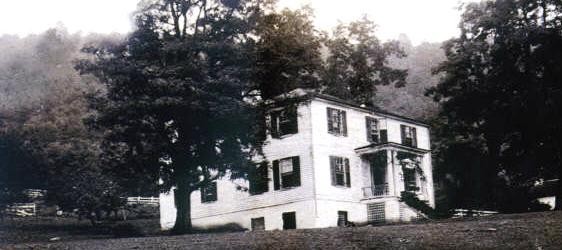|
|
 |
|
|
History of Mount Welby
 | | The Original Mt. Welby in Maryland | THE HOUSE:
Mt. Welby is nestled on the southern slope of Rattlesnake Mountain in the beautiful Blue Ridge Mountains near Linden, Virginia. In the early 1700’s, Rattlesnake Mountain fell within a 126,000-acre tract of land owned by Thomas Fairfax, Sixth Lord Fairfax. From his 2 million-acre estate, Lord Fairfax carved this enclave to serve as his private hunting preserve. Lord Fairfax named the area, “Manor of Leeds”, after his ancestral home in England, Leeds Castle. In the late 1700’s, a syndicate of land speculators, including brothers John and James Marshall, purchased Manor of Leeds from the heir of Lord Fairfax. John Marshall was an incredibly gifted individual who served as a Virginia Representative to Congress and as Secretary of State of the United States. His greatest achievement, however, was as Chief Justice of the Supreme Court. To this day, John Marshall still holds title to the longest serving Chief Justice of the Supreme Court. He is credited as the father of the present form of the Supreme Court, and for solidifying the Supreme Court as a coequal in our federal system. John’s younger brother, James, took ownership of the area surrounding Rattlesnake Mountain. Today, James Marshall’s historic home, Fairfield, is owned by the Marriott family. In the 1950’s, J.W. Marriott purchased the home as a family retreat. Marriott’s hotel chain, “Fairfield Inn and Suites”, is named for this home. Marriott’s property includes the eastern portion of Rattlesnake Mountain. Marriott's horse stables, currently open to the public for trail rides, is within ½ mile of Mt. Welby.
Evidence suggests that a dwelling, likely a log cabin, existed at the location of Mt. Welby in the early 1820s. The home as it exists today was built on the site circa 1856. The home was built in the Greek Revival style and looks strikingly like its namesake in Prince Georges County, Maryland, Mt. Welby at Oxen Cove and Oxen Hill National Park. The design of the home is a center-hallway, two-room over two-room, three-bay home with a large center stairway. A small secondary two-floor attachment in the rear was built with a narrow set of servant steps. The back lower room was likely a servants’ work area and the upper room likely served as the sleeping quarters for in-home servants. Originally, the home was adorned with three chimneys and 6 fireplaces. Over time, the chimney on the east wing of the home weakened beyond repair and was removed from the roof-line up; the original two fireplaces in the east wing do still exist, but as gas fireplaces. The original kitchen, as was the norm at the time, likely stood outside as a separate, small building. Over the decades, a small indoor kitchen was added to the rear of the home and any remnants of the exterior kitchen were removed. The exterior front of the home has a long stairway leading to a portico, which was originally adorned with Greek-style columns. Multiple outbuildings lay throughout the farm, including at least two bank barns, a carriage house, a smokehouse, a well house, and various other buildings. Because the farm originally housed 15 slaves, the farm also had slave quarters somewhere on the property; unfortunately, however, that historic location has long been lost.
THE FAMILY:
The builder of Mt. Welby was a 19th century upper-middle class gentleman named Richard Earle DeButts. DeButts hailed from a prominent family in northern Virginia and Maryland that was closely tied to other prominent families in the region, including the Dulanys, the Halls, and the Lees.
Richard Debutts purchased 550 acres on the south side of Rattlesnake Mountain from the Marshall heirs in 1856. He named his new home Mt. Welby for the Prince Georges County, Maryland, estate on which he was born and spent his early childhood. Richard’s grandfather, Dr. Samuel Debutts, was a wealthy Irish immigrant and prominent physician in the Washington, D.C. area. Dr. Debutts 206-acre estate stood along the Potomac River, just south of Washington, D.C. Dr. DeButts named his estate, Mt. Welby, for the ancestral home of his wife, Marianne Welby Debutts, who grew up at Welbourne Hall, Lincolnshire, England. Today, Dr. Debutts’ estate is the Oxen Cove and Oxen Hill National Park, and Dr. DeButts' original home, Mt. Welby, now serves as U.S. Park Service offices. The national park encompasses the entire area northwest of the intersection of Interstates 495 and 295 in Prince Georges County, Maryland.
Dr. and Marianne Debutts had three children, Richard Welby, Mary Ann Welby, and John Henry. The eldest child, Richard Welby, married Louisa Dulany, and they built their home, the historic estate Crednal, near Upperville, in Loudoun County, Virginia. Unfortunately, Richard Welby died as a young man, leaving young Louisa with two small children. Louisa later married James Edward Hall and remained at Crednal until her death. Louisa brought her two children fathered by Richard Debutts to her marriage with James Hall. She and James went on to have several children of their own, including a daughter, Sarah Martha Cowman Hall. Sarah went on to marry Richard Earle Debutts, and became the original matriarch of the Debutts family at Mt. Welby, Linden, Va.
Dr. Debutts’ second child, Mary Ann Debutts, married Louisa Dulany’s brother, John Peyton Dulany. John Dulany built his home next to his sister’s home, Crednal. John’s home is the historic estate known as Welbourne, also near Upperville. Like Mt. Welby, Welbourne was named for the ancestral home of Richard’s wife, Mary Ann, who, like her mother, was born at Welbourne Hall, in England.
Finally, the youngest son, John Henry Debutts, married Sophia Forest. Due to the untimely death of his older brother, Richard, John Henry inherited Mt. Welby and most of the family’s wealth. John and Sophia had two children, Mary Welby, born in 1820, and Richard Earle, born in 1823. Sadly, Sophia died at or near the time of Richard’s birth, likely from complications related to his birth. Tragedy struck again in 1831, when 8-year old Richard and 10-year old Mary, lost their father, John Henry. As minor children, and as orphans, the young Richard and Mary inherited Mt. Welby in Prince Georges County, and their father’s wealth. As was not uncommon at the time, the children were taken in by their aunt and uncle, Mary Ann Welby and John Peyton Dulany. The rest of their childhood was spent with their aunt, uncle, and cousins at Welbourne. One cousin with whom they were raised was Richard Henry Dulany, only one year the senior of Richard Earle. Richard Dulany later gained fame as a Colonel in the army of the Confederate States of America (CSA). He gained his greatest fame, however, as the founder of the Piedmont Hunt in Upperville, which is one of the oldest fox hunting clubs in the United States, and as one of the founders of the Upperville Horse and Colt Show, which is the oldest horse show in the United States.
Richard Earle's sister, Mary Welby went on to marry Richard Henry Carter, and the two built the historic estate Glen Welby, near Marshall, Virginia. Like Mt. Welby and Welbourne, Glen Welby was named for the ancestral home of the Welby’s, Welbourne Hall. Glen Welby later gained prominence as the home of Washington Post owner, Katherine Graham, and is still owned by the Graham family.
 | | George Washington on Blueskin | In 1844, Richard Earle married his neighbor and distant cousin, Sarah Martha Cowman Hall, who was the daughter of Richard Earle's former aunt, Louisa Dulany Hall. Richard Earle and Sarah Martha shared a great grandfather, Revolutionary War colonel, Benjamin Tasker Dulany. Colonel Dulany was a famed member of George Washington's inner circle and is credited with gifting George Washington his beloved horse, Blueskin. Blueskin is the gray-white horse on which many portraits of Washington were painted. At the end of the Revolutionary War, President Washington gifted Blueskin back to Colonel Dulany's wife, Elizabeth French. As for Sarah and Richard, they grew up as friends on their neighboring properties, Crednal and Welbourne respectively. The fact that Richard married Sarah, a distant cousin and neighbor, was not an unusual circumstance in the 19th century.
In 1843, Richard Earle and his sister, Mary Debutts, sold their family’s estate in Prince Georges County, Mt. Welby. Richard used his Mt. Welby windfall to purchase a 250-acre farm in Upperville, near Welbourne and Crednal. This farm was part of a larger tract of land known simply as “Lot Six”. A portion of Lot Six was also owned by Richard Earle’s cousin, Richard Henry Dulany. It was on this shared property that Richard Henry Dulany founded the Upperville Colt and Horse Show and, to this day, the show is held on this acreage. Although no direct evidence exists confirming Richard Earle Debutts’ assistance founding the show, the fact the show was started on property encompassing Richard’s property, and the fact that the founder was a close cousin with whom Richard Earle was raised, is strong circumstantial evidence that Richard Earle was at least marginally involved in the show’s founding. Regardless, Richard Earle was known as an avid horseman. In 1859, for example, Richard’s three-year old filly was awarded a silver Tiffany cup at the Upperville Horse and Colt Show. Richard Dulany had commissioned famed founder of Tiffany and Company, Charles Lewis Tiffany, to create silver cups as trophies for his show. Although Richard won such a cup in 1859, the subsequent history of the cup is unknown.
Richard and Sarah continued to live on their farm at Lot Six until the early 1850’s, when they were forced to auction the property due to a defect in the property’s deed. With the proceeds from the farm’s auction, Richard and Sarah purchased 550 acres on the side of Rattlesnake Mountain where they built their new home. They named this new home Mt. Welby, for Richard’s childhood home in Prince Georges County.
At Mt. Welby, Richard settled into the life of a gentleman farmer. Like many Virginians, during the Civil War Richard joined the Confederate cause. He enlisted in the army of the CSA where he joined the famed Mosby’s Rangers. Although difficult to confirm because of the dearth of accurate information about Civil War-era soldiers, Richard was alleged to have been one of the oldest of Mosby’s Rangers. Mosby’s Rangers were rumored to have stopped by Mt. Welby more than once as part of their constant movement throughout the region. One family legend claims Mt. Welby was once saved from destruction by Union soldiers. Shortly after the battle of Front Royal, in a not uncommon event, Union soldiers searched nearby homes for those harboring Confederate soldiers. As it happened, Union soldiers knocked on the doors of Mt. Welby in just such a search. Richard, off fighting elsewhere, was not at home. He had entrusted his Masonic ring to his bride, Sarah, who dutifully wore the ring on her hand. As the story goes, when the Union soldiers knocked at Mt. Welby, Sarah opened the door in such a way as to display Richard’s Masonic ring. The young officer leading the Union search noted Sarah wearing the ring and, being a Mason himself, ordered Mt. Welby not be searched, possibly saving the home from destruction. Richard survived the war unscathed and returned to his life as a gentleman farmer. Richard and Sarah raised eight children at Mt. Welby. Their descendants remained prominent in the fabric of the Virginia landscape. Richard and Sarah’s grandson, William Hunter Debutts who spent his childhood at Mt. Welby, married the granddaughter of General Robert E. Lee, Mary Custis Lee; she was the daughter of Captain Robert E. Lee Jr, and they named their son, Robert E. Lee Debutts. Other descendants include Dr. Richard Debutts, a prominent Upperville physician, Harry Ashby Debutts, a president of the Southern Railway, and John Dulany Debutts, the last CEO of AT&T prior to its antitrust breakup into the baby Bells.
Mt. Welby stayed in the ownership of the original family until the year 2000, when the first non-family member purchased the home. Over the many decades of Mt. Welby’s existence, the original family wealth had been diluted and, by 2000, Mt. Welby stood in disrepair. The front porch had collapsed, and the beautiful property was overgrown and dilapidated. Owing to inheritance, the farm had been divided, and divided again; by 2000, the original 500 plus acres on which the home stood had been whittled down. The home sat on a plot of just over 60 acres. Fortunately, to this day, a line of descendants do still own 150 plus acres directly across the road from Mt. Welby.
In 2000, the new owner, a Washington, D.C. developer named Michel Heitstuman, surveyed, designed, cleared, and cleaned. By 2005, the run-down home had been completely restored in the spirit of the original home. Staying with the traditional theme of the home, Michel added a beautiful, glassed expansion to the rear of the house. The kitchen was rebuilt and expanded and an upper deck was added over the kitchen. He also finished the basement into living spaces, exposing the incredible stone foundation of the home. In the decade to follow, Michel completed a major restoration of the grounds, adding an 18th century physic garden and upscale modern amenities including a fire pit and a hot tub. He also restored the beautiful Civil War era stone walls adorning the property.
In 2016, Kristen Anderson and Phil Custead purchased Mt. Welby, and became the third and present owners of the home. Kristen and Phil continued Michel’s loving restoration. In the spirit of Richard Earle Debutts’ love of horses, in the summer of 2016, Kristen and Phil added a five-stall horse barn to the property. Their horses, Sophie, Mollie, and Gracie, live a wonderful life grazing on Mt. Welby’s pastures, along with three goats, Sally, Scarlett & Sadie. Their beloved mixed labs, Niko and Nina, for whom the farm is named, enjoy the wonderful grounds as well.
|
|
|
